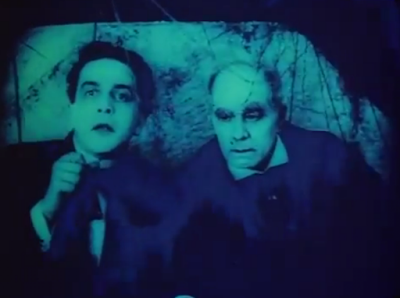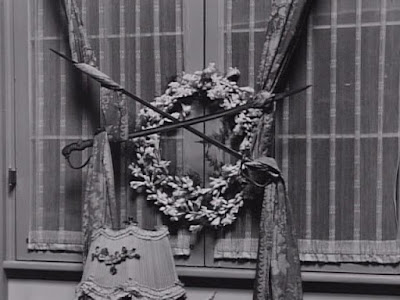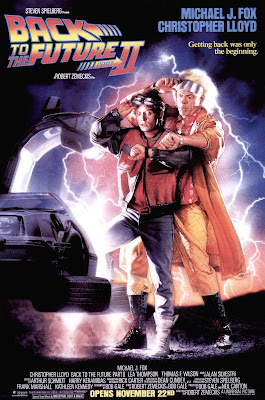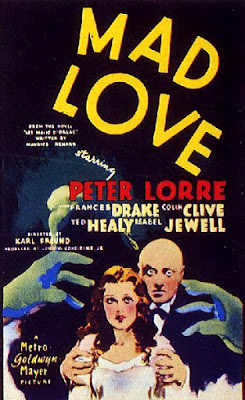The
Cabinet of Dr. Caligari (1920) Starring: Werner Krause, Conrad Veidt, Friedrich
Feher, Lil Dagover, Hans Twardowski. Directed by Robert Wiene. Screenplay by Hans
Janowitz and Carl Meyer. Produced by Rudolf Meinert and Erich Pommer Run Time:
71 minutes. Germany Black and White, Silent, Horror.
Hailed by such a luminary film critic as
Roger Ebert as "the first
true horror film", The Cabinet of Dr. Caligari is also considered the
quintessential work of German Expressionist cinema. German Expressionism, and I’ll try not to
sound too much like school, was a movement that began during World War I and
reached its peak during the 1920’s. Largely confined to Germany, which was
isolated following the War, it was part of a general expressionist movement in
Europe at the time and was seen in such diverse areas as architecture, painting
and cinema.
The German
Expressionist movement in cinema produced several horror films, such as The
Cabinet of Dr. Caligari, The Golem: How He Came into the World (1920) and
Nosferatu (1922). Hollywood, in general would benefit from an emigration of
German filmmakers, bringing the likes of F.W. Murnau, Fritz Lang and Karl
Fruend, who got their starts in expressionism to the U.S. The movement, which
used light and dark effectively, is also seen as a pre-cursor of sorts to Film
Noir.
While there
are varying stories about the production of the film, the story starts with Hans Janowitz and
Carl Meyer. The two writers were introduced by a mutual friend, an actor named
Ernst Deutsch, in the summer of 1918 and Gilda Langer, an actress with whom
Meyer was in love, encouraged the two to write together. The screenplay took
six weeks to write during the following winter. As with any writer, their past
experiences influenced the story. Meyer, who had claimed to be have a mental
breakdown to get out of the war, had gone through extensive psychiatric
examination and modeled Dr. Caligari after one of his doctors. Janowitz claimed
to have seen a murder in 1913 near an amusement park in Hamburg’s Reeperbahn,
beside the Holstenwall, which would be used as the name of the village in the
story. Janowitz also claimed that the name Caligari was inspired by a rare
booked called “Unknown Letters of Stendhal,” which featured a letter from the
French novelist to a French officer named Caligari. However, no record exists
of such a letter and it has been suggested that Janowitz made it up.
Through Fritz Lang, the two met with Erich
Pommer, the head of production at the Decla-Bioscop film studio on April 19,
1919. Pommer asked them to leave the script, but Meyer was adamant about
reading it to him and Pommer acquiesced. So impressed was Pommer that he
refused to let them leave until they had signed a contract, which gave Pommer
authority to make any changes he felt were appropriate. Pommer may have loved
the story, but he was also drawn to the idea that the film would be inexpensive
to make.
Economics being what they were at the time,
even though Germans were seeing more movies, the currency and the economy were
tanking due to the Treaty of Versailles requirement that Germany pay
reparations to the Allied victors. German studios, like Decla-Bioscop, were
looking for projects that could be made inexpensively and still be accessible
to foreign audiences, which were used to looking at films made in Hollywood.
Pommer’s decision to use painted backgrounds, rather than built sets, was
driven by this commercial reality.
Pommer’s first choice to direct the film was
Lang, but he became unavailable since he was already filming another film, The
Spiders. Robert Weine was selected as a replacement. Weine had been a writer of
films, since 1913 and a director since 1915, but The Cabinet of Dr. Caligari
would be his most famous and influential work.
The sets were designed by Hermann Warm, who
was brought into the project by producer Rudolf Meinert. Given a copy of the
script and asked to come up with a proposal for the design. Warm felt that the
film needed an abstract design. Warm brought Walter Reimann and Walter Rohrig
into the project. The Walters were painters and stage designers, as well as
Warm’s friends. The trio spent a full day and night reading the script and it
was supposedly Reimann who suggested an expressionistic approach. Director Weine would also claim the idea as
his own.
 |
| The abstract expressionist sets with their painted on shadows is one of the things that makes the film distinct. |
Meinert agreed with the idea, no matter who’s
it may have been, and encouraged the artists to make the sets as “crazy” as
possible. But again, like Pommer, finances drove the decision. Since
Expressionism was hot at the time, he counted on the artistic style to garner
attention and make the film profitable, even if the film was not received well
critically. The artists were given free rein with set design, costumes and
props. It’s said Warm worked primarily on the sets, Rohrig handled the painting
and Reimann took charge of the costumes.
The role of Dr. Caligari was supposedly
written with Werner Krauss in mind, an actor Deutsch had brought to Janowitz’s
attention during rehearsals for a Max Reinhardt play. While the role of Cesare
was originally intended for Deutsch, it went to another actor, Conrad Veidt.
Both Krauss and Veidt had a background in Expressionist theater and helped with
final touches to their character’s makeup and costume, knowing how important
their appearance would be as part of the film’s visual style.
Filming took place at the Lexie-Atelier film
studio in late December 1919 through the end of the following January. It is
shot exclusively in a studio which was considered unusual at the time, but
dictated by the Expressionistic style the filmmakers were after. The
involvement of the writers during the filming is disputed, with Janowitz
claiming they refused to allow for changes in the script during production, and
Pommer claiming Meyer was present every day on set. But Warm claims that
neither was never present on the set or involved in any discussions during the
production of the film.
Because the Lexie-Atelier studios, built in
1913 were rather small, some things in the script had to be cut or changed
because they couldn’t be filmed, including a procession of gypsies and several
scenes involving horse carriages.
The
film opened on February 26, 1920, less than one month after it was completed.
The film had been marketed like any other film, with an extensive campaign
prior to its opening. And despite Pommer’s fears that "It will be a horrible failure for all of us!" the
film was a success, showing at the Marmorhaus theater in Berlin, where it premiered for four weeks,
unusual for the times.
 |
| The story is told as a flashback. Here Francis (Friedrich Feher) tells his enthralled audience of one, his story. |
Most of the film is told in the form of a flashback using a framing story. The film opens with Francis (Friedrich Feher) sitting on a bench next to an older man. Francis is complaining that the spirits have driven him away from his family and home, when a dazed woman named Jane (Lil Dagover) passes them. Francis explains to the man that she is his "fiancée" and that they have suffered a great ordeal.
 |
| While Francis is telling his story, his "fiancee" Jane (Lil Dagover) saunders by. |
The story Francis relates takes place in Holstenwall, a shadowy village of twisted buildings and spiraling streets. Francis and his friend Alan (Hans Heinrich von Twardowski) are both in love with Jane, but their competition is good-natured. The friends plan to attend the town fair together.
 |
| The village of Holstenwall as depicted in the film. |
Meanwhile, a mysterious man
named Dr. Caligari (Werner
Krauss) goes to see the city clerk about a permit to
present a sideshow at the fair. The city clerk, who sits in a very high chair,
is rude to Dr. Caligari, but ultimately Caligari receives the permit. However,
that night, the clerk is found stabbed to death in his bed.
 |
| Dr. Caligari (Werner Krauss) on his way to see the city clerk. |
The
next morning, Francis and Alan stop at Dr. Caligari's spectacle, which features
a somnambulist named Cesare (Conrad Veidt). Caligari opens
a coffin-like box to reveal the sleeping Cesare, but upon Dr. Caligari's
orders, Cesare awakens and answers questions from the audience.
 |
| Dr. Caligari's sideshow act at the fair. |
Even
though Francis tries to stop him, Alan asks Cesare "How long will I
live?" To their horror the answer is, "Until dawn." Later that
night, a figure breaks into Alan's home and stabs him to death in his bed.
Grief-stricken over the death of his friend, Francis investigates the murder with the help of Jane and her father, Dr. Olsen (Rudolf Lettinger). Dr. Olsen obtains police authorization to investigate the somnambulist.
 |
| Alan (Hans Heinrich von Twardowski) watches helplessly as Cesare enters his bedroom. |
Grief-stricken over the death of his friend, Francis investigates the murder with the help of Jane and her father, Dr. Olsen (Rudolf Lettinger). Dr. Olsen obtains police authorization to investigate the somnambulist.
The
police, meanwhile, apprehend a criminal (Rudolf Klein-Rogge) who is caught
attempting to stab an elderly woman. While the criminal confesses to trying to
kill the woman, he denies any involvement in the other murders. He was only
trying to use those murders as cover for the one he was trying to commit.
One night, Francis stakes out Dr. Caligari and sees what appears to be Cesare sleeping in his box. However, the real Cesare is sneaking into Jane’s home while she sleeps. He is about to stab her with a knife, but decides to kidnap her instead. After a struggle, he carries her out through the window out to the street.
One night, Francis stakes out Dr. Caligari and sees what appears to be Cesare sleeping in his box. However, the real Cesare is sneaking into Jane’s home while she sleeps. He is about to stab her with a knife, but decides to kidnap her instead. After a struggle, he carries her out through the window out to the street.
 |
| Cesare (Conrad Veidt) in Jane's (Lil Dagover) home. |
But a
mob chases Cesare through the streets, but he eventually drops Jane and runs
off, only to collapse and die. After
confirming the criminal had been locked up during Jane’s abduction, Francis and
the police further investigate Dr. Caligari’s sideshow and discover that the
Cesare in the box is really only a dummy.
 |
| Cesare carries Jane through the streets of Holstenwall with a mob (not shown) chasing him. |
In the
confusion, Dr. Caligari escapes, but Francis tracks him to a nearby insane asylum.
Francis
learns that Dr. Caligari is not a patient, but rather is the asylum's director.
While the doctor is sleeping, Francis, with help from the asylum staff, goes
through the director's records and finds his diary. The entries reveal the
director’s obsession with the story of an 18th-century mystic named Caligari,
who used a somnambulist named Cesare to commit murders in northern Italian
towns. The director’s obsession gets the best of him when a somnambulist is admitted
to the asylum. Caligari turns him into his own Cesare. The director is shown screaming "I must become Caligari!”
 |
| The asylum director is obsessed with becoming Dr. Caligari. |
Francis and the doctors call the police to Dr. Caligari's office, where they show him Cesare's corpse. Dr. Caligari then attacks one of the members of his staff and has to be restrained in a straitjacket. Dr. Caligari is then placed into one of the cells in his own asylum.
The
narrative returns to the present, where Francis concludes his story. But in a
twist, it is revealed that Francis is actually an inmate in the very asylum.
Jane and Cesare are both patients there as well. Jane believes herself to be a
queen, and Cesare is fully awake. Dr. Caligari is, in fact, the asylum’s
director.
This
time, it is Francis who attacks him, but he is restrained in a straitjacket and
placed in the same cell Dr. Caligari was confined to in his story. After
examining Francis, the director confidently announces that, now that he
understands Francis' delusion, he knows how to cure him.
The film did well in foreign markets, but as
with practically everything about this film, how well is a bit of a discussion.
After the film opened in Paris on March 2, 1922, it supposedly played at one
theater for seven consecutive years. In the U.S., Samuel Goldwyn’s Goldwyn
Distributing Company bought the rights and opened the film in New York on April
3, 1921 and in Los Angeles on May 7, 1921. Protests in Los Angeles forced the
theater to pull the film. However, the protests were not over content, but
rather the fear that Hollywood jobs would be lost with the importing of German
films into the U.S. While box office wasn’t the public data it is today, it’s
hard to say how well the film did in release here. Two separate film historians
took a look at the available information from the time and came to different
conclusions, but what do you expect with this film.
Of the
actors in the film, Conrad Veidt is the best remembered today. He would be
America’s favorite Nazi to hate during World War II, most famously appearing as
Major Strasser in Casablanca (1942), sadly one of Veidt’s final films. A
fervent anti-Nazi, Veidt would flee Germany to the UK and then to America. When
it looked like he would typecast as a Nazi, he made sure to stipulate that they
always be shown as the villain.
Before
he left Germany, Veidt would appear in such classics as Waxworks (1924), The
Student of Prague (1926) and The Man Who Laughs (1928). In two of these films,
Waxworks and The Student of Prague, Veidt would appear with his Caligari
co-star, Werner Krauss.
Unlike Veidt, Krauss was very pro-Nazi and an anti-Semite. For a time after the war, he would be banned all together from the German stage and from films.
 |
| Conrad Veidt as Cesare in The Cabinet of Dr. Caligari carrying Jane. |
Unlike Veidt, Krauss was very pro-Nazi and an anti-Semite. For a time after the war, he would be banned all together from the German stage and from films.
The
Cabinet of Dr. Caligari is one of the most interpreted mainstream films ever
made. Due to when it was released and the subsequent rise of socialism in
Germany, the film has been interpreted to be foreshadowing of Hitler’s rise to
power, illustrating German’s need for a strong ruler. From Caligari to
Hitler: A Psychological History of the German Film by Siegfried Kracauer proposed
a connection between the apolitical and escapist orientation of films made
during the Weimar-era and the rise of totalitarianism of the Nazi’s Third
Reich.
Kracauer’s
thesis was disproven by Thomas Elsaesser in his book Weimar Cinema and After.
Elsaesser describes Kracauer’s work as a “historical imaginary.” Elsaesser
argues that Kracauer had not watched enough films to be able to support his
idea. Also the discovery of the original screenplay has disproven some of
Kracauer’s assumptions, including the idea that the framing story was added
after production, when in fact the script does contain one, although different
than the one that was filmed.
But
Halloween is not the time to be discussing the rise of Nazism in post-World War
I Germany. Horror films are selected for their scare factor, not their
political allusions, present or not.
In the
end, though, the film probably won’t scare anyone today. A killing sleepwalker
seems mild by today’s standards. And the film, despite its 100% rating on
Rotten Tomatoes, suffers from a slow pace, again as judged through a modern
filter, and overly melodramatic acting, sadly common with silent films. What
you can’t say with words has to be expressed in exaggerated gestures that
either seem funny or too old school. The title cards used have so much screen
time that you are almost able to learn the German language.
Still,
there is something seminal about the film that makes it right for Halloween: this
is one of the earliest examples of the horror genre. While a sleepwalker might
not seem like a scary monster, there is a little of the Dr. Frankenstein and
his monster in the Dr. Caligari / Cesare relationship. And as noted above, the
use of shadows, both real and painted, is a precursor to the shadowy
world of Film Noir that was given life by German expressionist filmmakers who
immigrated to the U.S.
Personally,
I find Nosferatu (1922) to be scarier, but The Cabinet of Dr. Caligari is a
perfect example that a film doesn’t have to be expensive to be effective or
have an impact.
Be sure to check out our other Horror film reviews here.
Be sure to check out our other Horror film reviews here.




























